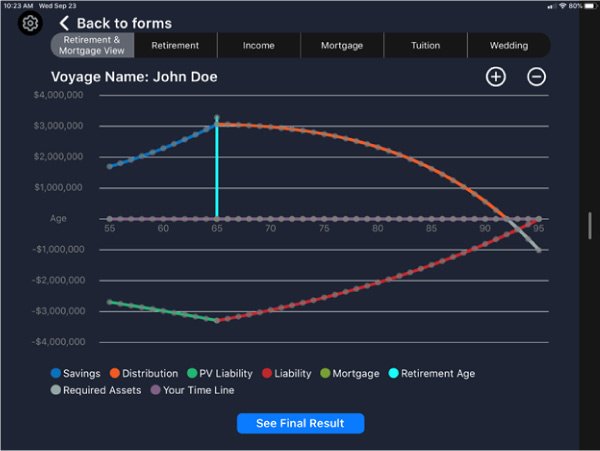Jeff from Real Intelligence discusses different facets of financial planning & what is the impact of different methods of investing for financial literacy.
Alpha, beta, standard deviations, r squared, sharpe ratios – is it any wonder why people shut down when they start following the financial media? So many interviews, always with people on either side of the debate to entertain the audience. The question is: does any of this help people put their kids through college? Does it help to fund their children’s weddings? Does it instill confidence when people decide to retire? These are important observations we have to make when evaluating how well Americans understand financial literacy and how well they are doing towards fulfilling their family’s financial obligations. At least Jim Cramer’s show has a few “Booyahs” to keep the viewer watching. The challenge with that show is it is less about strategic thinking and more about how to behave with the next trade.
Strategic thinking is at the heart of confidence building when addressing financial literacy. If we can visualize our financial future using realistic assumptions, wouldn’t we be able to make better decisions about how much to save each month, how to invest those dollars, understand the challenges of inflation, and avoid conflicts along the timeline of our lives? Traditional financial planning has used a combination of old school bar graphs and spreadsheets that leave the viewer cross-eyed. A new tool is available to tackle each of these strategic opportunities and will help anyone visualize their financial future in less than ten minutes. It is an app called Dynamic Map and is a free download on the Apple app store or Google Play. Not only will it handle all of those calculations on a yearly basis for each of life’s major financial obligations, but it will allow for changes in assumptions which alter the visual instantly allowing for strategic thinking. I have used these graphs in many articles I have written because it gives the user an immediate sense of what is possible versus what is improbable.
When deciding how to invest, it is important to address whether or not the investor is in accumulation phase or the distribution phase of their lives. In accumulation phase, we are focused on growing the value of our assets by purchasing shares of stocks and balancing the portfolio with some bonds to better manage volatility. The traditional financial planning method would put the investor through some kind of risk profile questionnaire to assess their tolerance for downside risk. I challenge this process frequently because an investor’s tolerance for risk changes based on recent experience. For example, if John Doe completes the risk profile questionnaire in September 2019, he probably displayed a high tolerance for downside risk. The driving force behind that was he was experiencing the longest running bull market in history. Volatility was no where to be found and high returns were easy. Fast forward one year later and John Doe is nervous about downside risk due to a global pandemic, a self-imposed shut down of the American economy and uncertainty about the prospects of rising inflation in the near future. Instead of building an allocation model based on a flawed risk profile questionnaire, I am a big fan of the aging process. This allows the investor to take on the most risk at the point farthest from the distribution date while reducing that risk each year as the date gets closer. This completely ignores the emotions of the investor on any given date and manages the account for liquidity when liquidity is needed. In distribution phase, he will be focused on generating income while still providing enough growth to combat inflation. There have been some distribution plans that include taking systematic withdrawals from a balanced portfolio in retirement. This is often referred to as the “4% plan” and is supported by a program called “Monte Carlo analysis.” I challenge this method because nobody will actually take just 4% each year in retirement. For example, let’s imagine we were taking $40,000 from a $1,000,000 account. The following year the account drops ten percent due to a market downturn. Will the family take 4% from the $900,000 base or will they take the same income they took the previous year? Of course they will take the $40,000! However, that now represents a 4.4% withdrawal. If the slide continues, the percentage withdrawal continues to rise which creates an unsustainable path. Instead of this systematic withdrawal approach, I am a fan of a bucketing strategy where the most conservative income producing assets are available for withdrawal in those earliest years. The second bucket is income producing as well, but carries a little more risk as it relates to duration and credit quality, but delivers more yield. The third bucket will have the most risk and will include the inflation reserve, but this bucket is way out on the timeline and should not be feared due to how well time manages volatility. As you can see, distribution planning can be very difficult and certainly will require careful planning and flawless execution.
Regardless of the distribution strategy John Doe chose, he has to account for inflation. Remember, it is common for retirees to live thirty years into retirement and even a small amount of inflation can significantly erode purchasing power over a period that long. An inflation reserve account is dramatically different than an emergency reserve account that is invested conservatively with a focus on liquidity. An inflation reserve account is an actively managed account that invests in commodities (especially gold), growth stocks in the beginning of the inflationary cycle, but changing to dividend paying stocks and TIPS (Treasury inflation protected securities), and ultimately bonds which carry much higher yields due to rising interest rates that occur as a consequence to the rising inflation. Of course, this inflation reserve is only a piece of the overall portfolio. This risk has never been more real than right now. Fed Chairman Jay Powell recently announced the Federal Reserve’s comfort for above average inflation moving forward. Let’s take a look at how just a 1% increase in long-term inflation might impact John Doe. As you can see below, John is only a little short of his savings target of just over $3 million at age 65. This scenario assumed a lifetime average rate of return of 5.5% with a 2% inflation rate. His income in retirement was planned to be $12,000 per month in today’s dollars (the Dynamic Map app automatically accounts for the future value of those dollars). John wanted to plan for income lasting to age 95, but the app shows him running out of money at age 92. This is actually not too bad. (Keep in mind, this scenario ignored Social Security payments to keep this simple. The app does allow for that income to be inputted as well).
Jeff Mount, President, Real Intelligence LLC
As a “disruptor” in the financial services industry, Jeff has challenged the status quo for over a decade by influencing financial advisors to deliver a higher degree of client service through the effective training and implementation of the essential family office. As a result, these advisors saw an average increase of $28 million in new assets under management in the first year upon completion of the training. Today, Jeff leads a team whose focus is on disrupting the ineffective delivery of financial planning data often seen with traditional planning software. Together, with his business partner Mike Helgesen, Jeff stands ready to help the middle-class millionaire engage in strategic discussions with DM (Dynamic Map) certified advisors or, for those who prefer to do it themselves, take action based on sound strategic thinking by easily comprehending this visual output of financial planning data.

What if inflation does start to rise? How will John’s retirement plan be impacted? Let’s see:

As you can see by the graph, his need for additional capital increased to slightly over $4 million from just a one percent increase in inflation. Since he didn’t have that much money his assets run out at age 85. This is the consequence of the Federal Reserve accepting a higher than average inflation rate moving forward!
I hope this demonstration of today’s financial planning tools help you to visualize your financial future in a way that inspires strategic discussions. Once the challenges have been identified, it might make sense to review various strategic options with a high-quality financial planner who understands the human-centered method of financial planning.
For more such Updates Log on to https://fintecbuzz.com/ Follow us on Google News Fintech News

Jeff Mount
As a “disruptor” in the financial services industry, Jeff has challenged the status quo for over a decade by influencing financial advisors to deliver a higher degree of client service through the effective training and implementation of the essential family office. As a result, these advisors saw an average increase of $28 million in new assets under management in the first year upon completion of the training. Today, Jeff leads a team whose focus is on disrupting the ineffective delivery of financial planning data often seen with traditional planning software. Together, with his business partner Mike Helgesen, Jeff stands ready to help the middle-class millionaire engage in strategic discussions with DM (Dynamic Map) certified advisors or, for those who prefer to do it themselves, take action based on sound strategic thinking by easily comprehending this visual output of financial planning data.



